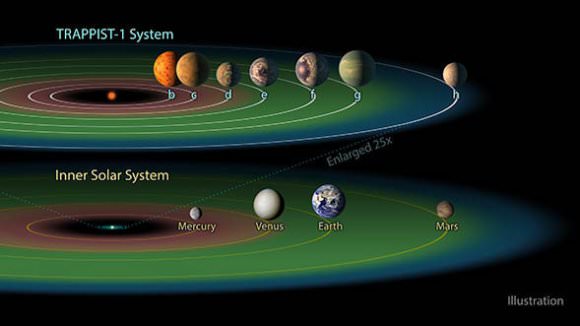In February of 2017, NASA scientists announced the existence of seven terrestrial (i.e. rocky) planets within the TRAPPIST-1 star system. Since that time, the system has been the focal point of intense research to determine whether or not any of these planets could be habitable. At the same time, astronomers have been wondering if all of the system's planets are actually accounted for.
For instance, could this system have gas giants lurking in its outer reaches, as many other systems with rocky planets (for instance, ours) do? That was the question that a team of scientists, led by researchers from the Carnegie Institute of Science, sought to address in a recent study. According to their findings, TRAPPIST-1 may be orbited by gas giants at a much-greater distance than its seven rocky planets.
The study, titled "Astrometric Constraints on the Masses of Long-Period Gas Giant Planets in the TRAPPIST-1 Planetary System", recently appeared in The Astronomical Journal. As they indicate in their study, the team relied on follow-up observations made of TRAPPIST-1 over a period of five years (from 2011 to 2016) using the du Pont telescope at the Las Campanas Observatory in Chile.
Using these observations, they sought to determine if TRAPPIST-1 could have previously-undetected gas giants orbiting within the outer reaches of the system. As Dr. Alan Boss - an astrophysicist and planetary scientist with the Carnegie Institute's Department of Terrestrial Magnetism and the lead author on the paper - explained in a Carnegie press statement:
"A number of other star systems that include Earth-sized planets and super-Earths are also home to at least one gas giant. So, asking whether these seven planets have gas giant siblings with longer-period orbits is an important question."
For years, Boss has conducted an exoplanet-hunting survey with the co-authors of the study - Alycia J. Weinberger, Ian B. Thompson, et al. - known as the Carnegie Astrometric Planet Search. This survey relies on the Carnegie Astrometric Planet Search Camera (CAPSCam), an instrument on the du Pont telecope that searches for extrasolar planets using the astrometric method.
This indirect method of exoplanet-hunting determines the presence of planets around a star by measuring the wobble of this host star around the system's center of mass (aka. its barycenter). Using CAPSCam, Boss and his colleagues relied on several years of observations of TRAPPIST-1 to determine the upper mass limits for any potential gas giants orbiting in the system.
From this, they concluded that planets that were up to 4.6 Jupiter Masses could orbit the star with a period of a year. In addition, they found that planets up to 1.6 Jupiter Masses could orbit the star with 5-year periods. In other words, it is possible that TRAPPIST-1 has some long-period gas giants orbiting its outer reaches, much in the same way that long-period gas giants exists beyond the orbit of Mars in the Solar System.

Three of the TRAPPIST-1 planets – TRAPPIST-1e, f and g – dwell in their star's so-called "habitable zone. CreditL NASA/JPL
If true, the existence of these giant planets could resolve an ongoing debate about the formation of the Solar System's gas giants. According to the most-widely accepted theory about the Solar System's formation (i.e. Nebular Hypothesis), the Sun and planets were born of a nebula of gas and dust. After this cloud experienced gravitational collapse at the center, forming the Sun, the remaining dust and gas flattened out into a disk surrounding it.
Earth and the other terrestrial planets (Mercury, Venus and Mars) all formed closer to the Sun from the accretion of silicate minerals and metals. As for the gas giants, there are some competing theories as to how they formed. In one scenario, known as the Core Accretion theory, the gas giants also began accreting from solid materials (forming a solid core) which became large enough to attract an envelop of surrounding gas.
A competing explanation - known as the Disk Instability theory - claims that they formed when the disk of gas and dust took on a spiral arm formation (similar to a galaxy). These arms then began to increase in mass and density, forming clumps that rapidly coalesced to form baby gas giants. Using computational models, Boss and his colleagues considered both theories to see if gas giants could form around a low-mass star like TRAPPIST-1.
Whereas Core Accretion was not likely, the Disk Instability theory indicated that gas giants could form around TRAPPIST-1 and other low-mass red dwarf stars. As such, this study provides a theoretical framework for the existence of gas giants in red dwarf star systems that are already known to have rocky planets. This is certainly encouraging news for exoplanet-hunters given the spate of rocky planets have been found orbiting red dwarfs of late.
Aside from TRAPPIST-1, these include the closest exoplanet to the Solar System (Proxima b), as well as LHS 1140b, Gliese 581g, Gliese 625b, and Gliese 682c. But as Boss also noted, this research is still in its infancy, and much more research and discussion needs to take place before anything can be said conclusively. Luckily, studies such as this one are helping to open to the door to such studies and discussions.
"Gas giant planets found on long-period orbits around TRAPPIST-1 could challenge the core accretion theory, but not necessarily the disk instability theory," said Boss. "There is a lot of space for further investigation between the longer-period orbits we studied here and the very short orbits of the seven known TRAPPIST-1 planets."
Boss and his team also assert that continued observations with the CAPSCam and further refinements in its data analysis pipeline will either detect any long-period planets, or put an even tighter constraint on their upper mass limits. And of course, the deployment of next-generation infrared telescopes, such as the James Webb Space Telescope, will assist in the hunt for gas giants around red dwarf stars.
Further Reading: Carnegie Institute of Science, The Astronomical Journal
No comments:
Post a Comment